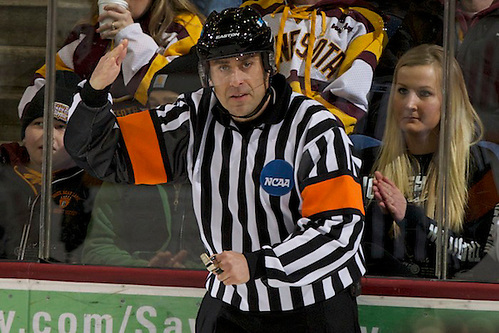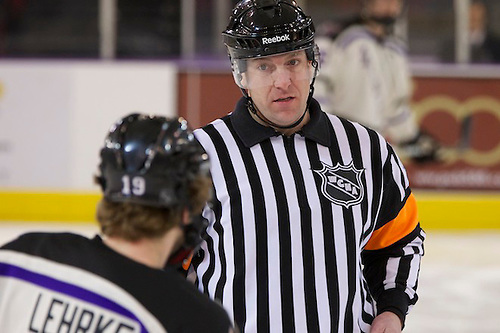
The two big screens at the front of the conference room show the center-ice TV angle of a 100-foot stretch pass that ends with a jarring, illegal hit in the neutral zone.
Steve Piotrowski asks those assembled to make the call by pressing a button on their handheld polling devices: ‘A’ for major penalty, ‘B’ for a major and game misconduct or ‘C’ for a major and game disqualification.
No one chooses the last, most severe option — a DQ carries with it an automatic one-game suspension.
Sixteen votes are cast to assess only a five-minute major penalty; the 22 others choose to eject the offending player from the game with a game misconduct. By no stretch of the imagination is there a consensus, which tells you that reasonable people can disagree on the same subject.
It also tells you that on-ice officials can disagree on what the call should be on a play, a clear indication of the human factor involved in the role.
These are Big Ten referees and linesmen assembled in the room for their preseason clinic, a day-long primer on rule changes and a refresher on procedures.
And it’s more than one play on which they do not all hold the same opinion.
Piotrowski, the Big Ten coordinator of ice hockey officials, puts another clip on the screens and asks a question on the severity of the penalty that should be assessed. Again, the split is 22-16. Another play gets a 20-18 divide and yet another goes 21-17.
The takeaway: Different officials will see the same play differently.
“Now enter into the dynamic having to make a split-second decision with one look at real-time speed,” Piotrowski says. “Based upon where you’re positioned and where you see that and without looking at it again, you could come out of that with, ‘Boy, I thought that guy was hit in the head but in reality it was shoulder to shoulder.’ Or, ‘I thought that was a disqualification but in reality it should have been only a game misconduct.'”
The purpose of the clinic, Piotrowski says, is to get the officials confident in their rules knowledge and ready to take the ice in October under some significant changes in the way the game is officiated.
There are subtle changes to faceoff locations and procedures that officials must have down cold before opening night. There are the yearly points of emphasis to keep in mind.
2014-15 points of emphasis
The NCAA men’s and women’s ice hockey rules committee each year issues a set of items for extra attention in the coming season. Here are the three for 2014-15:
Diving and Embellishment: Coaches, conference commissioners, coordinators of officials and on-ice officials must work collaboratively to rid the game of both diving to draw a penalty and embellishing actions to deceive game officials. The committee encourages conferences to develop ways to curb this type of behavior and if appropriate use supplemental discipline. Game officials continue to be encouraged to communicate as a crew and share information when diving or embellishment is in question.
Delaying Tactics: The committee encourages stringent use of the delay of game rules in place, especially during situations where a team may not change its players by rule (e.g., icing). In the rules survey, coaches and administrators overwhelmingly supported a crackdown on these actions. Players on the ice when play is stopped for any violation which does not permit a change of players, (e.g., icing) are required to go immediately to the faceoff location. Any player skating to the bench or otherwise delaying will receive a warning for the first offense and a bench minor penalty on the second and subsequent offense.
Goalkeeper Interference: Clarifying incidental contact between attacking players and the goalkeeper is a key initiative of the committee in this cycle. The goalkeeper must be allowed to play the position, but attacking players also must be given rights to legally obtained space. Through video and directives, the committee will provide more clarity on this issue. Essentially, the crease is the goalkeeper’s area and any contact that prevents the goalkeeper from playing the position must not be allowed. Incidental contact outside of the goal crease is allowed and attacking players have rights to the space outside the goal crease. Finally, deliberate contact with the goalkeeper (regardless of where it occurs) that prevents playing the position should result in a disallowed goal, penalty or both.
There are new protocols for video replay usage for the four-person crew to consider. And there are refreshers needed on elements like the four criteria needed for a penalty shot to be awarded.
They cover it all on one September Saturday at the sparkling Big Ten headquarters outside of Chicago.
They cover it because Piotrowski — as he makes clear multiple times during the day — will not tolerate a lack of rule knowledge.
“Your job is to make sure you know the rules like the back of your hand,” he tells the officials. “I can defend you to the end of the world on your judgment. But if you miss a rule, I have no choice but to tell that coach [you] screwed up.”
That comes up after a clearly unsatisfactory percentage of correct answers to a question on an interactive rules test using the polling devices.
In a follow-up interview, Piotrowski says exemplary rule knowledge is a “difference-maker” in how he views officials.
“Here’s a group of guys that their primary role and responsibility is to officiate a hockey game per the current rules that are in place. And if you don’t understand those rules or you misinterpret those, I can’t make excuses for guys,” says Piotrowski, who’s also the secretary-rules editor of the NCAA men’s and women’s ice hockey rules committee. “Because our guys are accountable just like the players are accountable and the coaches are accountable.”
The first part of accountability is showing up.
For this clinic, the independent contractors that are hired by the Big Ten to officiate hockey games pay for their own travel.
It has a social component — officials think of themselves as being all part of the same team, just the one that no one ever cheers for.
But it’s business, and the business at hand is to get themselves ready for the upcoming season.
“You really start to get excited again,” says Scott Bokal, a veteran referee from St. Louis who’s joining the Big Ten corps this season. “I think we all look forward to this. When you start to see the videos and knock the rust off of your brain, so to speak, you start to get excited.”
Being forced to think about close calls and quick decisions a month before the season starts is a good way to start getting in game mode, lineman Steve Waters says.
Officials would do all that kind of preparation on their own if they had to, he says, out of dedication to their craft.
“But everybody getting together and getting a chance to talk about what’s going on, and then building that rapport with each other before the season starts, it really helps bring it all together so that come October we’re ready to go,” says Waters, who also works the lines for Atlantic Hockey games and is based in Pittsburgh.

No one but officials truly knows the thanklessness of officiating, but that shared experience builds a bond.
“When you’re out there working a game, you’ve got 10,000 people that absolutely hate you,” Waters says. “And you guys are all a team out there. You guys are all brothers. I have your back and you have my back.”
Early in the day, the officials talk in depth about how much to have each other’s back.
The subject is diving and embellishment, one of this season’s points of emphasis.
It’s no secret that referees take offense to attempts to deceive them with a dramatic fall. In addressing the group, Piotrowski calls it “a disgrace to the game” that needs to be eliminated through a collective effort of officials, coaches and players.
Piotrowski emphasizes that he’s not directing the officials to call more diving and embellishment penalties, only to feel empowered to call them when they present themselves.
He adds that if a player shows a pattern of exaggeration, he’ll be identified as a repeat offender so officials can take that knowledge into the game.
Referee Brian Hill asks Piotrowski if it should be a more frequent practice to get the crew together in situations when one referee calls a penalty but others see embellishment on the play.
“I think that’s great,” Piotrowski responds. “That has to continue.”
As evidence of the kind of detail those in the officiating business put into their knowledge of the rule book, the group spends about 10 minutes on a rule change that might be considered minor.
Starting this season, when a team is called for a hand pass or playing the puck with a high stick, the faceoff comes back one zone closer to its goal from where the infraction was committed. In the past, the faceoff took place in the offending team’s defensive zone, which some coaches thought was too punitive, Piotrowski says.
Referee Marco Hunt asks how that change will be received by coaches if it ends up benefiting the violator. An example is floated: A penalty killer launches the puck down ice from deep in his zone and a member of the power-play unit deflects it inside the blue line with a high stick, but the puck travels all the way down ice before it’s played by the offending team and the whistle blows.
Instead of the faceoff coming back into the power-play unit’s defensive zone, under the new rule it’ll take place in the neutral zone just outside of its attacking zone.
Piotrowski confirms that may happen and reinforces a thought he shared early in the presentation: There will have to be some adjustments in the way the officials think.
In the end, that’s one of the most essential parts of the day. College hockey changes its rule book only once every two years, but those changes bring new, sometimes unfamiliar ways of doing things.
But a faceoff rule can’t be misapplied and an opportunity for video review can’t be missed because an official doesn’t remember one of this year’s changes.
“Their job is to embrace all the information,” Piotrowski says. “Our job is to create an atmosphere of learning. It’s also to provide them the tools and information so they really feel comfortable about embracing it.”


